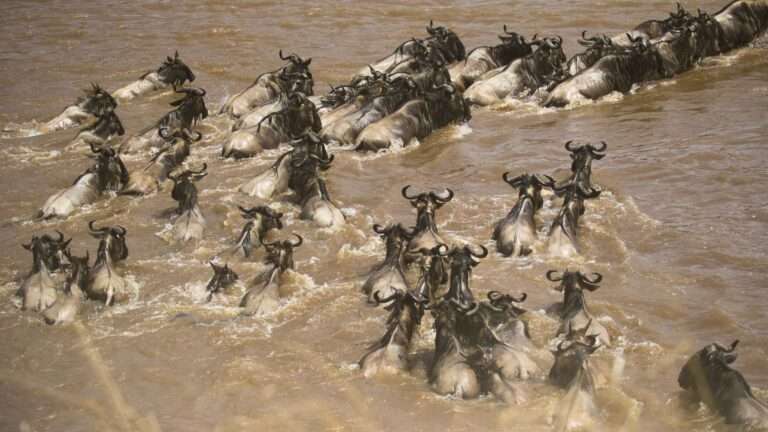January in Tanzania is warm and dry, particularly in the northern regions. This is a fantastic time to witness the Great Migration in the Serengeti, where over a million wildebeest gather in the Ndutu region for calving season. The newborns, although adorable, do attract a fair share of predators, making for thrilling wildlife action. Meanwhile, Zanzibar enjoys balmy weather, perfect for lounging on its pristine beaches and snorkelling in crystal-clear waters. January offers both thrilling wildlife drama and peaceful beach relaxation.
In February, Tanzania remains warm and dry, continuing to offer prime conditions for safari-goers. The calving season in the Serengeti’s Ndutu region is still in full swing, making predator sightings a daily event. This time of year promises high-intensity wildlife interactions. Over in Zanzibar, the weather is pleasantly warm, a great backdrop for diving enthusiasts exploring the island’s vibrant coral reefs. February provides a balanced mix of adrenaline-fueled wildlife viewing and serene beach experiences.
March sees the beginning of the long rains in Tanzania, especially in the northern regions, but it’s not a washout. Early in the month, you can still catch the tail end of the Great Migration in the Serengeti. The lush, green landscape can make for captivating photographs. Down in Zanzibar, the weather starts to become more humid, but it’s still a fine time for beach activities before the heavier rains set in. March offers a transitional but rewarding travel experience.
April ushers in the long rainy season across Tanzania, especially in the Serengeti, where the migration begins to head north through the central Serengeti. While the rains can make some roads impassable, the landscape transforms into a lush paradise. For those seeking the beach, Zanzibar also experiences increased rainfall, making it a quieter time to visit. If your clients don’t mind a bit of rain, April can provide a peaceful, verdant backdrop for both safari and beach activities.
May continues with the long rainy season, causing parts of the Serengeti to become beautifully green and teeming with life. The migrating herds move northward, and although game viewing might require more patience, it can be richly rewarding. Zanzibar also sees substantial rain, which means fewer tourists and lower prices. The island’s spice tours and cultural experiences remain a highlight, rain or shine. May is great for those who appreciate nature’s quiet moments.
By June, Tanzania starts to dry up, with the Serengeti offering excellent game-viewing opportunities as the Great Migration heads toward the Grumeti River. The drying landscape concentrates wildlife around water sources, making for easier spotting. Zanzibar also sees a return to dryer weather, with comfortable temperatures perfect for water sports and relaxation. June marks the beginning of peak travel season, offering your clients the best of both safari and beach experiences.
July is one of the best months for witnessing the Great Migration in the Serengeti, with the herds gathering to cross the Grumeti River. This dramatic spectacle, complete with crocodiles lying in wait, is a highlight for many travelers. In Zanzibar, July offers dry and sunny weather, ideal for beach activities and island hopping. With clear skies and a buzz of activity, July is perfect for those looking to enjoy wildlife and the idyllic Indian Ocean shores.
August continues to deliver prime safari experiences, with the Great Migration moving toward the Mara River. The river crossings, fraught with danger, attract plenty of predators, offering spectacular viewing opportunities. Zanzibar enjoys dry, sunny weather, perfect for diving, snorkeling, and lounging on its beautiful beaches. This month continues high-season magic—whether your clients are in search of intense wildlife moments or relaxing seaside bliss.
September maintains Tanzania’s excellent safari conditions. The Great Migration crosses into Kenya but remains visible in the northern Serengeti. Dry conditions also mean wildlife is easier to spot around remaining water sources. Zanzibar stays sunny and dry, maintaining its reputation as a beach lover’s paradise. September’s weather and migration patterns offer a balanced experience for both adventure seekers and sun worshippers.
In October, the Serengeti starts receiving short rains, reviving the landscape. The Great Migration begins to make its return journey from Kenya, and game viewing remains strong, especially in the northern areas. Zanzibar experiences the short rainy season but still enjoys plenty of sunshine, with the rains making the island’s foliage particularly lush. October provides a lovely mix of wildlife and rejuvenated landscapes, appealing to both adventure and leisure travelers.
November sees more short rains in Tanzania, causing the Serengeti to flourish once again. The Great Migration continues its southern trek, offering good viewing opportunities as the herds spread out. Zanzibar’s weather is mixed, with short spells of rain making the island a bit quieter than usual—great for those seeking peace. November offers a blend of vibrant green landscapes and fewer crowds, making it an appealing time for a relaxed yet engaging visit.
December in Tanzania enters the short dry season, making it a popular time for visiting the Serengeti. The Great Migration moves to the southern plains, where they prepare for another calving season. It’s a great time for wildlife viewing without the intense crowds of mid-year. In Zanzibar, December is warm and sunny, perfect for beach holidays and festive celebrations. Ending the year in Tanzania offers both the thrill of watching the migration and the joy of a tropical beach retreat.
























